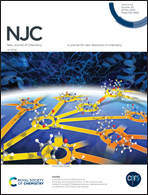Linker-assisted structuration of tunable uranium-based hybrid lamellar nanomaterials†
Abstract
Obtaining bulk materials ordered at the nanoscale using nanoparticles as building blocks is a new challenge for scientists and is of primary interest in some research areas. In this study, we developed a simple one-pot route towards nanostructured hybrid materials based on uranium oxide through a non-hydrolytic condensation process under mild solvothermal conditions (T = 160 °C) using ditopic organic linkers as structuring agents. The obtained materials present a sand rose morphology composed of agglomerated nanometric sheets with a lamellar substructure. Nanometric sheets are composed of inorganic fringes consisting of a studtite phase [(UO2)O2(H2O)2]·2H2O that alternates with organic fringes formed by the structuring organic linker. A multiparametric study based on SAXS experiments and TEM analyses has highlighted the control of structural parameters by varying some synthesis conditions. The interlamellar distances are tunable from 1.60 nm to 1.94 nm through the length of the structuring linker and the inter-sheet distance from 1.85 nm to 2.10 nm through synthesis temperature. This efficient one-pot route appears to be very promising for the production of tunable multiscale nanostructured hybrid materials and can be implemented in many research areas, paving the way for various applications.



 Please wait while we load your content...
Please wait while we load your content...